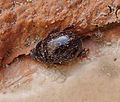| Hybosoridae Temporal range: | |
|---|---|
 | |
| Hybosorus roei | |
| Scientific classification | |
| Kingdom: | Animalia |
| Phylum: | Arthropoda |
| Class: | Insecta |
| Order: | Coleoptera |
| Suborder: | Polyphaga |
| Infraorder: | Scarabaeiformia |
| Superfamily: | Scarabaeoidea |
| Family: | Hybosoridae Erichson, 1847 |
| Subfamilies [1] | |
Hybosoridae, sometimes known as the scavenger scarab beetles, is a family of scarabaeiform beetles. The >600 species in 78 extant genera occur widely in the tropics, but little is known of their biology.
Contents
Hybosorids are small, 5–7 mm in length and oval in shape. Color ranges from a glossy light brown to black. They are distinctive for their large mandibles and labrum, and their 10-segmented antennae, in which the 8th antennomere of the club is deeply grooved and occupied by the 9th and 10th antennomeres. The legs have prominent spurs.
The larvae have the C-shape and creamy white appearance typical of the scarabaeiforms. The 4-segmented legs are well-developed; the front legs are used to stridulate by rubbing against the margin of the epipharynx, a habit unique to this family.
Adults are known to feed on invertebrate and vertebrate carrion, with some found in dung. Larvae have been found in decomposing plant material. Little more is known of their life histories.
The group has been long recognized as distinct, primarily because of the larval characteristics, either as a distinct family or as a subfamily of Scarabaeidae, though its constituency was greatly expanded with the inclusion within it of the former family Ceratocanthidae.
- Hybosorus roei

